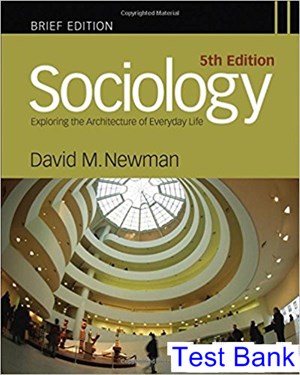Instant download Sociology Exploring the Architecture of Everyday Life Brief Edition 5th Edition Newman Test Bank pdf docx epub after payment.

Product details:
- ISBN-10 : 1506345859
- ISBN-13 : 978-1506345857
- Author: David M. Newman
Adapted from Sociology: Exploring the Architecture of Everyday Life, 11th edition, David Newman’s goal is the same for this briefer, stream-lined version: to write a textbook that “”reads like a real book.”” The author shows students how to see the “unfamiliar in the familiar”—to step back and see organization and predictability in their take-for-granted personal experiences in Sociology: Exploring the Archicture of Everyday Life: Brief, 5th edition. Newman uses the metaphors of “architecture” and “construction,” to help students understand that society is not something that exists “out there,” independently of themselves; it is a human creation that is planned, maintained, or altered by individuals. Instead of surveying every subfield in sociology, the more streamlined coverage focuses on the individual and society, the construction of self and society, and social inequality in the context of social structures.
Table of contents:
PrefaceAcknowledgmentsAbout the Author
Part I- The Individual and Society
Chapter 1- Taking a New Look at a Familiar World Sociology and the Individual The Insights of Sociology The Sociological Imagination Conclusion
CHAPTER HIGHLIGHTS KEY TERMS
Chapter 2- Seeing and Thinking Sociologically How Individuals Structure Society Social Influence: The Impact of Other People in Our Everyday Lives Societal Influence: The Effect of Social Structure on Our Everyday Lives Statuses and Roles Groups Organizations Social Institutions Family Education Economy Politics and Law Religion Health Care Military Mass Media Culture Values Norms Social Structure in a Global Context Three Perspectives on Social Order The Structural-Functionalist Perspective The Conflict Perspective Symbolic Interactionism Conclusion
CHAPTER HIGHLIGHTS KEY TERMSPart II- The Construction of Self and Society
Chapter 3- Building Reality: The Social Construction of Knowledge Understanding the Social Construction of Reality Laying the Foundation: The Bases of Reality Culture and Language Self-Fulfilling Prophecies Faith and Incorrigible Propositions Building the Walls: Conflict, Power, and Social Institutions The Economics of Reality The Politics of Reality The Medium Is the Message Appreciating the Contributions of Sociological Research The Empirical Nature of Sociological Research Qualitative and Quantitative Research Theories, Variables, and Hypotheses Modes of Research Experiments Field Research Surveys Unobtrusive Research The Trustworthiness of Social Research Samples Indicators Values, Interests, and Ethics in Sociological Research Conclusion
CHAPTER HIGHLIGHTS KEY TERMS
Chapter 4- Building Order: Culture and History Dimensions of Culture Material and Nonmaterial Culture Global Culture Subcultures Cultural Expectations and Social Order Social Institutions and Cultural Norms Norms and Sanctions Norms and Emotions Cultural Relativism and Ethnocentrism Cultural Variation and Everyday Experience Health and Illness The Sexes Conclusion CHAPTER HIGHLIGHTS KEY TERMS
Chapter 5- Building Identity: Socialization Genes, Social Structure, and the Construction of Human Beings Socialization: Becoming You The Acquisition of Self The Differentiation of Self Language Acquisition and the Looking-Glass Self The Development of Role Taking Resocialization The Self in a Cultural Context Socialization and Stratification: Growing Up With Inequality Social Class Race and Ethnicity Gender Institutions and Socialization Education Religion Mass Media Conclusion CHAPTER HIGHLIGHTS KEY TERMS
Chapter 6- Supporting Identity: The Presentation of Self Forming Impressions of Others Social Group Membership Physical Appearance Verbal and Nonverbal Expression Managing Impressions Dramaturgy: Actors on a Social Stage Front Stage and Back Stage Props Image Making The Surgical Alteration of Appearance Political Portraits Social Influences on Impression Management Race and Ethnicity Social Status Mismanaging Impressions: Spoiled Identities Embarrassment Remedies for Spoiled Identities Stigma Conclusion CHAPTER HIGHLIGHTS KEY TERMS
Chapter 7- Building Social Relationships: Intimacy and Families Life With Others Social Diversity and Intimate Choices Exogamy Endogamy Religious Endogamy Racial and Ethnic Endogamy Social Class Endogamy Family Life Defining Family Historical Trends in Family Life Trends in Family Structure Trends in Household Size Trends in Divorce Cultural Variations in Intimacy and Family Family and Social Structure How Other Institutions Influence Family The Influence of Law and Politics The Influence of Religion The Influence of Economics How Social Diversity Influences Family Family Challenges Divorce The Normalization of Divorce Children, Divorce, and Single Parenting Family Violence Intimate-Partner Violence Child Abuse and Neglect Intimate Violence in a Cultural Context Personal and Institutional Responses to Intimate Violence Conclusion CHAPTER HIGHLIGHTS KEY TERMS
Chapter 8- Constructing Difference: Social Deviance Defining Deviance Absolutist Definitions of Deviance Relativist Definitions of Deviance The Elements of Deviance Explaining Deviant Behavior Deterring Deviance Labeling Deviants Linking Power, Deviance, and Social Control The Criminalization of Deviance The Social Reality of Crime Wealthy, Corporate, and White-Collar Crime The Menace of Illegal Drugs The Medicalization of Deviance Individualizing Complex Social Issues Depoliticizing Deviance Conclusion CHAPTER HIGHLIGHTS KEY TERMS
Part III- Social Structure, Institutions, and Everyday Life
Chapter 9- The Structure of Society: Organizations, Social Institutions, and Globalization Social Structure and Everyday Life Social Dilemmas: Individual Interests and Structural Needs The Tragedy of the Commons The Free Rider Problem The Structure of Formal Organizations Bureaucracies: Playing by the Rules The Construction of Organizational Reality Organizations and Institutions Organizational Networks Within Institutions Institutional Pressures Toward Similarity Globalization and Social Institutions Economics Education Religion Conclusion CHAPTER HIGHLIGHTS KEY TERMS
Chapter 10- The Architecture of Stratification: Social Class and Inequality Stratification Systems Slavery Caste Systems Estate Systems Social Class Systems Sociological Perspectives on Stratification The Structural-Functionalist View of Stratification The Conflict View of Stratification The Marxian Class Model Neo-Marxist Models of Stratification Weber’s Model of Stratification Class Inequality in the United States Class and Everyday Life Class Distinctions The Upper Class The Middle Class The Working Class The Poor What Poverty Means in the United States The Poverty Line The Near-Poor The Poverty Rate The Consequences of Poverty Poverty and Health Poverty and Education Out on the Streets Why Poverty Persists Enduring Disparities in Income and Wealth The Social Benefits of Poverty The Ideology of Competitive Individualism Global Development and Inequality The Global Economic Gap Explanations for Global Stratification Global Financial Organizations Multinational Corporations Conclusion CHAPTER HIGHLIGHTS KEY TERMS
Chapter 11- The Architecture of Inequality: Race and Ethnicity Race and Ethnicity: More than Just Biology Histories of Oppression and Inequality Native Americans Latino/as African Americans Asian Americans Muslim Americans Racial and Ethnic Relations Personal Racism Stereotypes Prejudice and Discrimination Colorism The Privilege of Colorlessness Class, Race, and Discrimination The Cultural Ideology of Racism Racism in Language The Myth of Innate Racial Inferiority Institutional Racism: Injustice Built Into the System Racial Inequality in the Economic System Racial Inequality in the Health Care System Racial Inequality in the Educational System Remedies for Institutional Racism Global Perspectives on Racism Conclusion CHAPTER HIGHLIGHTS KEY TERMS
Chapter 12- The Architecture of Inequality: Sex and Gender Sexism at the Personal Level Sexism and Social Interaction Sexual Orientation Sexual Violence against Women Rape as a Means of Social Control Victim Blaming The Ideology of Sexism: Biology as Destiny Institutions and Gender Inequality Masculinized Institutions Gender Inequality in Health and Health Care Gender Inequality in Families Gender Inequality in Education Gender Inequality in the Economy The Sex-Segregated Workplace The Wage Gap The Global Devaluation of Women Conclusion CHAPTER HIGHLIGHTS KEY TERMS
Chapter 13- Demographic Dynamics: Population Trends The Influence of Birth Cohorts Baby Boomers Generation X The Millennium Generation Demographic Dynamics Population Growth Global Imbalances in Population Growth Politics, Culture, and Population Growth Age Structure Geographic Distribution Migration within a Country Migration from One Country to Another Population Trends in the United States Immigration and the Changing Face of the United States The of the United States Conclusion CHAPTER HIGHLIGHTS KEY TERMS
Chapter 14- Architects of Change: Reconstructing Society Social Change The Speed of Social Change Causes of Social Change Environmental and Population Pressures Cultural and Technological Innovation Diffusion of Technologies and Cultural Practices Social Movements Types of Social Movements Elements of Social Movements Ideology Resource Mobilization Bureaucratization Political Opportunity Structure The Sociological Imagination Revisited Conclusion and Farewell CHAPTER HIGHLIGHTS KEY TERMS
Glossary
References
Index
People also search:
Sociology Exploring the Architecture of Everyday Life Brief Edition 5th Edition
Sociology Exploring the Architecture of Everyday Life Brief Edition 5th Edition pdf
Sociology Exploring the Architecture of Everyday Life
|
what is sociology of everyday life |





